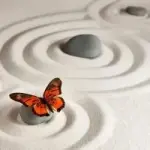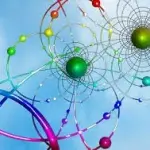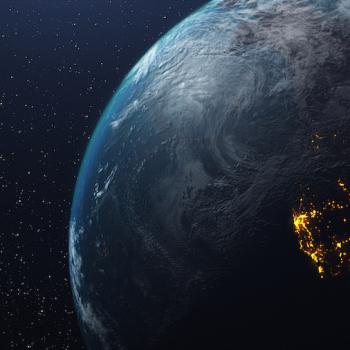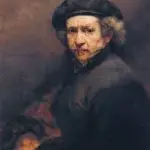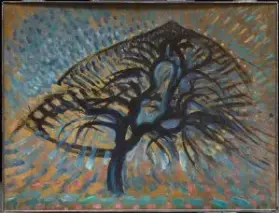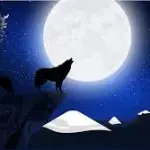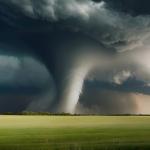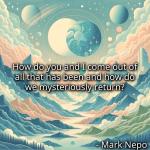
A tablet, dated from the fourth century B.C., was found in a tomb in Southern Italy. It contained instructions on what to do after dying, including what to say when one met the guardians of the pool of Memory: One was to say to them “I am a child of Earth and starry Heaven, but of Heaven is my true lineage.”
The idea of a separation between an earthly, bodily being and a celestial spiritual one is paradigmatic for virtually all Western spirituality. It was present in the Orphic cults of the Mediterranean, given a philosophic validation by Plato, full spiritual articulation by Plotinus, and integrated into Christianity by the church fathers, particularly Augustine.
It is not until Nietzsche that we hear a confident, articulate challenge to the idea. He says
Remain true to the earth, my brethren, with the power of your virtue! Let your bestowing love and your knowledge be devoted to the meaning of the earth!…Let it not fly away from the earthly and beat against eternal walls with its wings! (1)
While Nietzsche boldly asserts that we are of the earth, he does not really address the reasons why the dualism between the earthly and celestial had seemed so obvious for so long to the best minds of Western civilization. Naturalism, and the scientific findings that support it, provides considerable evidence against the old view, but it also doesn’t explain the persistence of dualism.
In addition to that between the earthly and the spiritual, these dualisms include those of body and mind, the natural and the artificial, and the creator and creation. It is this last one I want to address here. In its place I propose that the creating and the created are one and the same – two aspects of a single dynamic, creational cosmos.
That Nature is creational seems to me an undoubtable fact. Look around you and you will see novel, highly organized entities. From rock crystals to biological organisms to human artifacts the world around us is rife with such organization, such creation.
In using the word “creational” I am not suggesting a theory for how or why Nature is creational, only that it is. And I am certainly not suggesting that there is some intentional direction to Nature’s creativity, quite the opposite.
Perhaps, it would be safer to say that Nature is self-organizing and this process of self-organization gives rise to increasingly complex and novel forms of organization – but the end result of this unfolding process of self-organization is precisely what the theist calls “the Creation.” And this is my justification for saying that the “creation” and its creator are one and the same; Nature creates itself. It is creative.
Addressing Objections of a Dualist
There is no generally accepted theory for why the universe if creational in the way suggested. There are, however, some interesting cosmological theories that address the issue. The most interesting I’ve read is Lee Smolin’s theory of Cosmological Natural Selection. It, however, is far from generally accepted. Lacking such an explanation, the theist can claim that we have no solid ground upon which to reject the idea of a creator God separate from the creation.
This may be true, but we have even less of a theory for the existence of such a creator God. From the perspective of scientific explanation, such a God is pure miracle. If the theist can base his creator on a miracle, then we can base Nature’s creative ability on a miracle, and we have at least the advantage of presenting a simpler idea – the idea that Nature starts our extremely simple and then slowly evolves greater complexity seems far simpler than that the most complex of entities – an omniscient, omnipotent, intentional God – should simply exist.
But the Naturalistic position is actually much stronger than this. Though an explanation for the origin of Nature’s ability to self-organize and give rise to higher and different kinds of organizing principles is lacking, we do have a good understanding of some intermediate self-organizing principles, most notably Darwin’s theory of evolution.
The implications of Einstein’s equation E=MC2 also strengthen the Naturalistic case. The idea that Nature needs an outside creator is largely based on the idea that the matter of which Nature is composed is inherently inert. An inert matter, it is reasonable to say, cannot self-move or self-create; it would need an outside mover, much as the bricks that make up a building need people to move and arrange them.
But Einstein’s equation shows that our ideas of a passive, inert matter are an illusion. The equation tells us that one of those dull, inert seeming bricks contain enough energy to shine forth with the luminosity of our sun if it could in an instant be converted to energy. Add to this the findings of quantum mechanics that tell us that all matter is both particle and wave, and we find that the true nature of matter is active and energetic. The seeming inertness of matter on earth is actually a rather special state.
So there was never a need for the “prime mover,” that Aristotle had invented to account for the origin of movement. Matter contains its own principle of movement. Add to this the nature of the four recognized forces and we see that matter, in addition to a principle of movement, has directions of movement. Gravity moves all matter toward other matter; it accounts for those collections of matter we call stars. Electromagnetic energy (EM) both attracts and repels and is exponentially stronger than gravity. EM accounts for the tremendous variety of molecules that can be produced in the world, including those that come together to form life.
The full story of how gravity, EM, and the strong and weak nuclear forces interact with matter and each other to generate the complex process of self-organization is beyond the scope of this article and some of the details of this story are still being discovered. But enough of the story is known that confidence in its accuracy is well justified.
We do not know, of course, how or why all this matter with its particular set of parameters abruptly appeared at some “moment” at the beginning of this Universe. This is a mystery. A truly Great Mystery (2). Several theoretical cosmologists have proposed something rather inaptly named “the multiverse” to account for these conditions. But how one could empirically verify the actual existence of the multiverse is problematic. So there is a certain aspect of faith in the belief that the “creator and the creation are one and the same.” But what we do know about the world points us in this direction. So along with the aspect of faith there is also a generous supply of reasons. The same cannot be said for the dualism of creator and created.
In addition, the naturalistic idea gets us out of the hopeless theological tangle of the question of how an all-knowing, all-powerful, all-good God created a world containing evil. The presence of what we call good and evil is no problem for a non-intentional, self-organizing world.
Once we accept that the creator and creation are one and the same, the rest of the dualisms easily fall by the way. Biology and neurology have already shown the untenability of a dualism of body and mind. With the erasing of this dualism, that between the natural and the artificial is also shown as unnecessary, though here, I think, a little more explanation is required (See note 3 below.)
Implications
The idea that there is some pervasive creative force in the world has been spoken of by mystics, philosophers and artists from all ages and corners of the world. Below are a few instances:
Nature’s creativity is “the force that through the green fuse drives the flower” to quote Dylan Thomas. Or the “presence” referred to by Wordsworth in his Tintern Abbey:
….And I have felt
A presence that disturbs me with the joy
Of elevated thoughts; a sense sublime
Of something far more deeply interfused,
Whose dwelling is the light of setting suns
And the round ocean and the living air,
And the blue sky, and in the mind of man:
A motion and a spirit that propels
All thinking things, all object of all thought,
And rolls through all things. (4)
Or Emerson’s Over-Soul, of which he poetically enthuses:
That Unity, that Over-Soul, which in every man’s particular being is contained and made one with all other….the soul of the whole; the wise silence; the universal beauty, to which every part and particle is equally related…this deep power in which we exist and whose beatitude is all accessible to us…[in which] the seer and the thing seen, the subject and the object, are one.” (5)
And finally from the Tao Te Ching:
There was something nebulous existing
Born before heaven and earth.
Silent, empty,
Standing alone, altering not,
Moving cyclically without becoming exhausted,
Which may be called the mother of all under heaven (6)
I could go on and on with examples of this idea. Many of these writings anthropomorphize this source of Nature’s creativity, but once we have the notion of Nature as both creator and creation, we can substitute this naturalistic idea for such theistic and anthropomorphic characterizations. The idea here is not only that we are interconnected with all things, but that we are interconnected through our common origin in the creational aspect of Nature.
And with this, Spiritual Naturalism is in touch with perhaps the deepest and most universal of spiritual ideas. One that speaks of our true origin and points us to the true nature of the self.
———–
Before ending, I’d like to return to the statement with which I began: “I am a child of Earth and starry Heaven, but of Heaven is my true lineage.”
I have rejected the dualistic interpretation of this saying, but I think there are other ways of looking at it. One is based on the idea that humans are of two natures: a first nature, which is primarily biological, and a second nature that is primarily cultural. (The distinction between nature and culture is not a dualism; “culture” is an emergence out of the biological, as the biological is an emergence out of the chemical, and the chemical an emergence from the simplest elements of physics). In most forms of spirituality the proper direction of growth is in the development of this second nature, and particularly of the most refined, which is to say the least egotistical, aspect of this second nature.
Understood thus, we could interpret the saying as “I am a biological being born of nature, but my aspiration is to be less moved by biological instincts and appetites and instead to live my life from the truest and most enduring principles. And guided by these principles to enter the kingdom of heaven that is within each of us.”
Subscribe to The Spiritual Naturalist Society
Learn about Membership in the Spiritual Naturalist Society
__________
The Spiritual Naturalist Society works to spread awareness of spiritual naturalism as a way of life, develop its thought and practice, and help bring together like-minded practitioners in fellowship.
NOTES
- Friedrich Nietzsche, from Thus Spoke Zarathustra, First Part, Section 22(2). A link to that section is provided.
- I develop the idea of this mystery in an article titled 1-1=The Great Mystery, published here on Feb. 6, 2020. article
- I provided more details on this in an article titled “The All-inclusive (What Naturalism Means to Me),” published Sept. 6, 2018.
- From Line Written a Few Miles Above Tintern Abbey by William Wordsworth. A link is provided to a version of the poem.
- From The Oversoul by Ralph Waldo Emerson. A link is provided to an on-line version.
- From the Tao Te Ching, verse 25, Ellen M. Chen translation.


